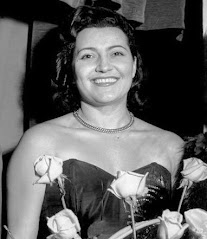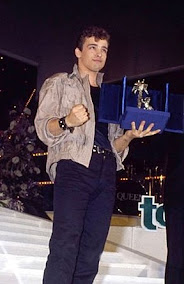Historic annual event that inspired Eurovision
 |
| Nilla Pizzi won the first two editions of the Sanremo Festival |
The festival is the world’s longest-running televised music contest, having been broadcast live by Italian state broadcaster Rai every year since 1955. The Eurovision Song Contest, which was staged for the first time in 1956, was modelled on Sanremo.
Compared with the 2024 edition - the 74th - which is due to be staged from February 6 to February 10 and in which the public vote is crucial - the inaugural competition was very different. There were 20 songs to be judged by a committee of experts who determined the result, but only three participants - Pizzi, Achille Togliani and the Duo Fasano, which consisted of twin sisters Dina and Delfina Fasano.
All of the participants had to perform all of the songs over the course of the three nights with the judges having to decide on both the merits of the song and the quality of the three different renditions before settling on their winner. They were so impressed with Pizzi that the following year she not only was their choice to win the competition but took second and third places too.
The first contest had a different venue. From 1951 until 1977 its home was the beautiful Liberty-style Casinò di Sanremo, situated a street or two back from the resort’s waterfront. In 1977, however, the casino was closed for renovations and the festival was switched to the Teatro Ariston, the biggest theatre in the town with an audience capacity much larger than the casino. With the exception of one year, the Ariston has hosted the competition ever since.
 |
| The Casinò di Sanremo, a fine example of Stile Liberty architecture, was the Festival's first home |
After successfully staging the competition in 1948 and 1949, however, the Viareggio organisers ran into financial difficulties and the planned 1950 edition was cancelled.
Help was at hand. In Sanremo, which in common with Viareggio and other resorts was looking for ways to revive economies left in tatters by World War Two, Piero Bussetti, administrator of the Casino di Sanremo, met with Giulio Razzi, the conductor of the Rai orchestra, to discuss relaunching the competition in Sanremo, to showcase previously unreleased songs.
It was through their initiative that the 1951 event, the last night of which was broadcast on the Rai radio station Rete Rossa, came to fruition.
Over the years the festival rules have been changed multiple times, allowing more participant singers, involving international artists and some high profile guests. Different categories were added to the main competition, including a section for newcomers that has been the launching pad for many illustrious careers, with Eros Ramazzotti, Laura Pausini and Andrea Bocelli among the list of past winners.
 |
| A youthful Eros Ramazzotti, best newcomer in 1984 |
Villa and Modugno each won the competition four times. Il Volo, winners in 2015 with Grande Amore, are competing again in 2024 among 27 artists bidding for the crown of champions.
At its most prestigious peak, guest performers at the festival have included Queen, Elton John, Tina Turner, Bon Jovi, Bruce Springsteen and Whitney Houston.
As well as providing the inspiration for the Eurovision Song Contest, which was launched in 1956 with a similar format, the link between Sanremo and Eurovision has been maintained by the Italian tradition of picking the winner of Sanremo as nation’s entry for Eurovision. Two of the three Italian successes at Eurovision - Gigliola Cinquetti in 1964 with Non ho l'età and the rock group Maneskin in 2021 with Zitti e buoni were Sanremo victors.
 |
| Sanremo was a holiday destination for the wealthy |
The resort of Sanremo in Liguria, which can be found 146km (91 miles) southwest of Genoa as the Italian Riviera extends towards France, enjoyed particular prestige even before the Music Festival put it on the cultural map. The town expanded rapidly in the mid-18th century, when the phenomenon of tourism began to take hold among the wealthy. Several grand hotels were established and the Emperor Nicholas II of Russia was among the European royals who took holidays there. The Swedish chemist Alfred Nobel, who bequeathed money in his will to establish the prizes that take his name, was so taken with the elegance of the town after his holiday visits that he made it his permanent home. Known as the City of Flowers, it is characterised by its Stile Liberty architecture (the Italian variant of Art Nouveau), of which the Casinò di Sanremo in Corso degli Inglesi is a beautiful example.
 |
| The Viareggio Carnival is famous for its huge and often highly symbolic floats |
Viareggio, which might have remained home to the contest now synonymous with Sanremo had the organisers of the first editions of the Italian Song Festival not run into financial difficulty, is a popular seaside resort in Tuscany, about 26km (16 miles) from the city of Lucca and a similar distance north of the port city of Pisa. It has beautiful sandy beaches and, like Sanremo, some fine examples of Liberty-style architecture, which include the Grand Hotel Royal. It may not have a music festival to compare with Sanremo but it does have the Viareggio Carnival, which is the most famous in Italy after the Venice Carnival. Dating back to 1873, the carnival is famous for its enormous papier-mâché floats, which parade along the resort’s promenade. Often sending up well-known figures from politics and entertainment in giant caricatures mounted on the floats, the carnival has a more humorous side than its better-known counterpart, contributing to a lively atmosphere around the town.

























